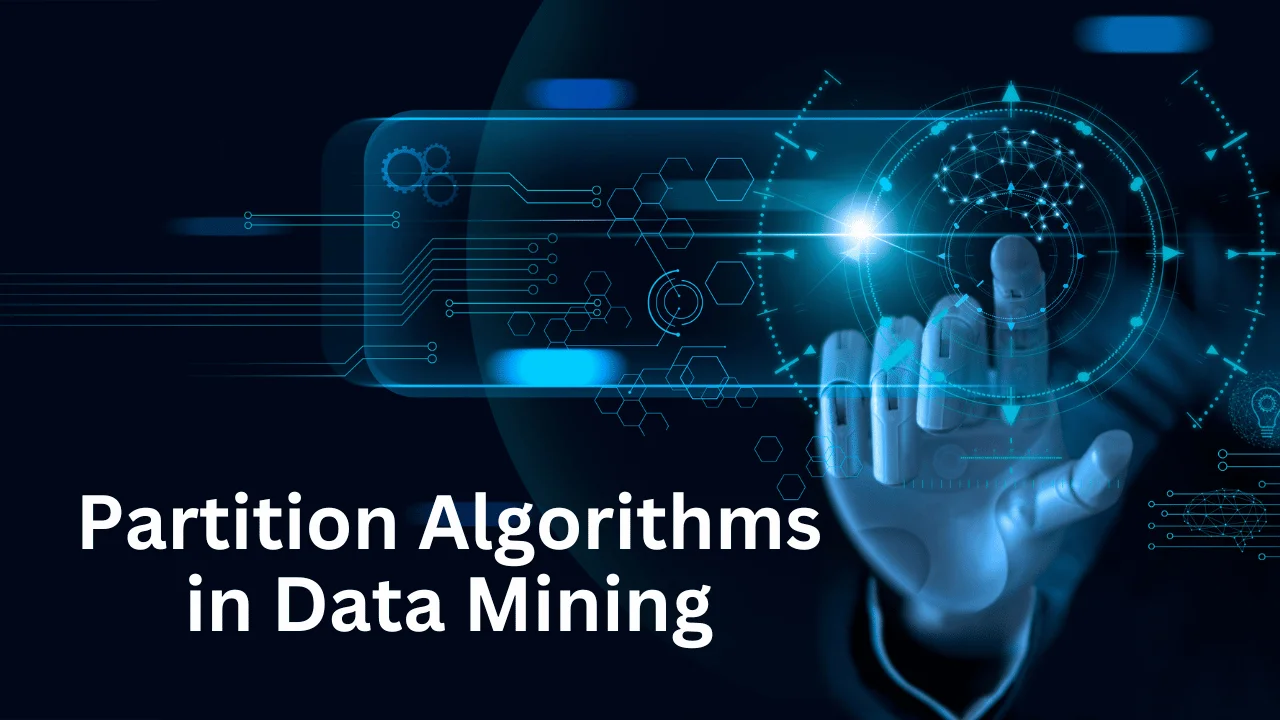Data mining would not be possible without partition algorithms, which are fundamental for the organisation and analysis of massive amounts of unstructured data. Partition algorithms in data mining facilitate better data interpretation and decision-making by dividing datasets into meaningful clusters. These algorithms enable different industries to discover hidden patterns and insights by understanding the distribution and structure of data without prior labelling.
Partition Algorithms: Function and Use
Why Partition Algorithms are Essential in Data Mining
Data mining’s unsupervised learning techniques rely on partition algorithms. They find patterns in the data and help analysts see connections and structures that weren’t there before. Market analysis, bioinformatics, and image processing rely on this segmentation to improve predictive analytics and make sense of complicated datasets.
Key Applications

Market Segmentation Using clustering
By dividing the market into subsets of customers with shared traits or habits, partition algorithms help companies maximise revenue. This segmentation enables more precise marketing and product development, which in turn maximises the use of resources and delights customers even more.
Enhanced Image Processing
Clustering algorithms aid in the segmentation of images into coherent parts within the realm of image analysis. Applications as diverse as autonomous vehicles and medical diagnostics rely on segmentation for tasks such as object recognition and scene analysis.
Bioinformatics Data Insights
Genomic sequences and other biological data can be better analysed and understood with the use of clustering in bioinformatics. Finding sets of related genes or proteins allows scientists to better understand intricate biological systems, which in turn helps them develop new drugs and find better ways to treat diseases.
Predictive Analytics in Various Domains
Partition algorithms allow predictive models to foretell future trends and behaviours by revealing patterns in past data. Industries like retail, healthcare, and finance rely heavily on this capability because it helps them plan for the future.
Core Techniques

K-means Clustering in Data Mining
One common method for data partitioning is K-means, which uses a fixed number (K) of clusters to organise the data. It begins with randomly chosen centroids, then uses distance metrics to iteratively assign data points to the closest cluster, and finally updates the centroids. When there are no more noticeable shifts in the cluster assignments or centroids, the procedure terminates.
Initialization and Centroid Selection
Both the efficiency of the algorithm and the quality of the clusters it produces are heavily dependent on the initial centroids chosen. This step is optimised using a variety of strategies, such as heuristic methods and random selection.
Assignment and Updating Phases
We first find the closest centroid for each data point, and then we recalculate the centroids as the average of all the clusters. The clusters are refined through this iterative process to better reflect the underlying data structure.
Convergence and Stopping Criteria
Once the centroids have stabilised, the algorithm stops iterating. This ensures that the clusters have reached a natural grouping based on the data, since no further significant changes have occurred.
Handling Outliers and Noisy Data
Outliers have the potential to affect K-means clustering in a negative way by distorting the cluster centres and resulting in less accurate clustering. Data preprocessing and the incorporation of robust distance measures are two techniques that help alleviate this problem.
K-medoids Algorithm in Unsupervised Learning
K-medoids is an improved version of K-means that is more resistant to outliers because it uses real data points as centroids, instead of theoretical ones. When an outlier has the potential to significantly impact the cluster average, this method shines.
Medoid Selection and Robustness
To improve cluster stability and interpretability, particularly when outliers and noise are present, K-medoids, in contrast to K-means, chooses data points as cluster centres.
Partitioning Around Medoids (PAM)
To improve cluster quality and robustness, the PAM algorithm iteratively tries to minimise the total distance between points and their medoids. This is a common implementation of K-medoids.
Applications in Outlier-Sensitive Domains
Financial fraud detection and ecological studies are two examples of domains where K-medoids excels because of the prevalence of outliers, which can corrupt average-based clustering.
Efficiency and Scalability Concerns
Compared to K-means, K-medoids is computationally more demanding, particularly for big datasets, but it provides better robustness. It is common for optimisations and approximations to be required to keep performance constant.
Future Trends in Partition Clustering Techniques
Improvements in partition algorithms’ accuracy, efficiency, and practicality are ongoing areas of research. More flexible and scalable solutions are emerging from the convergence of AI and ML, which can deal with the exponential growth in both the amount and complexity of data.
Integration with Deep Learning
To enhance the accuracy of feature extraction and clustering, deep learning models are being integrated with clustering algorithms. Complex data, like high-dimensional biological information and large-scale image datasets, can be analysed more sophisticatedly with this integration.
Scalability and Large Data Applications
In order to make the most of distributed computing platforms, algorithms are being fine-tuned to accommodate the explosion of big data. Modern methods such as cloud computing and parallel processing are making it possible to cluster large datasets in a reasonable amount of time.
Robustness and Adaptability
To make clustering results more robust and to reduce the need for manual tuning, new algorithms are being developed to automatically adjust parameters and adapt to different data characteristics.
Interdisciplinary Applications and Impact
Partition algorithms are finding new applications in fields like social network analysis and climate science, where they are driving innovation and policy development by helping to understand complex, multidimensional relationships.
Challenges and Solutions in Clustering Large Datasets
While partition algorithms are essential for handling and understanding massive datasets, they are not without their share of difficulties. If these are adequately addressed, their utility and application scope can be greatly expanded.
Scalability and Performance Issues
Conventional clustering algorithms may become computationally unmanageable when datasets increase in size. This is addressed by utilising state-of-the-art methods like distributed algorithms and parallel processing. These techniques increase the capacity to manage massive amounts of data while drastically decreasing processing time by distributing the workload across numerous processors or machines.
Accuracy in High-Dimensional Spaces
The curse of dimensionality, which occurs in high-dimensional data, causes distance metrics to increase, which in turn decreases cluster quality. To improve the performance of clustering algorithms, dimensionality reduction techniques are utilised. These techniques include Principal Component Analysis (PCA) and t-SNE, which reduce the number of dimensions while maintaining the essential structure of the data.
Dynamic Data Adaptation
In reality, datasets change and adapt over time. It is crucial in these situations to have adaptive clustering algorithms that can update clusters dynamically when new data comes in. Algorithms can adapt to new data without having to start the clustering process all over again; examples of this include incremental clustering and online learning techniques.
Cluster Partitioning in Unsupervised Learning
Partition algorithms are optimised using a variety of techniques to achieve their full potential. The purpose of these upgrades is to make the produced clusters more accurate and useful.
Feature Selection and Weighting
When it comes to clustering, not every feature in a dataset is gold. Better clustering results can be achieved by picking the most important features or giving them a weight based on their significance. To improve the feature set prior to clustering, methods such as chi-square test, feature importance scoring, and mutual information are employed.
Distance Metric Customization
Clustering results are very sensitive to the distance metric used. To improve the relevance and accuracy of the clustering process, additional metrics beyond the standard Euclidean distance can be used, such as Manhattan, cosine, and custom-designed functions. These metrics are tailored to specific data characteristics.
Cluster Validation and Quality Assessment
If you want your clusters to be meaningful and useful, you have to check their quality after you form them. The success or failure of a clustering effort can be determined by measuring its validity using metrics such as the silhouette coefficient, the Davies-Bouldin index, and the intra-cluster and inter-cluster distances.
FAQs
Q: What is a partition algorithm in data mining?
A partition algorithm in data mining is a method used to divide a dataset into non-overlapping subsets or clusters, based on specific criteria to maximize intra-cluster similarity and minimize inter-cluster similarity.
Q: How does the K-means algorithm determine the number of clusters?
The K-means algorithm requires the number of clusters (K) to be specified beforehand, often determined through methods like the elbow method or silhouette analysis.
Q: Why are K-medoids considered more robust than K-means?
K-medoids is more robust because it uses actual data points as cluster centers (medoids), making it less sensitive to outliers compared to K-means, which uses mean values for centroids.
Q: What are the main challenges in clustering large datasets?
The main challenges include scalability and performance issues, maintaining accuracy in high-dimensional spaces, and adapting to dynamically changing data.
Q: How can cluster quality be assessed?
Cluster quality can be assessed using metrics like the silhouette coefficient, Davies-Bouldin index, and by analyzing intra-cluster and inter-cluster distances to evaluate how well the clusters capture the underlying data structure.
Also Read: Neural Network in Data Mining: An Overview
Conclusion
Partition Algorithms in Data Mining are potent instruments for organising, analysing, and making sense of complicated, big datasets. The use of these algorithms has revolutionised various fields, such as bioinformatics and market segmentation, by illuminating previously unseen connections and patterns in massive amounts of data. New methods and tools are constantly improving their efficacy and usefulness, even though they face obstacles like scalability and performance in high-dimensional spaces. Partition algorithms, which optimise cluster partitioning and continuously adapt to changing data landscapes, are still leading data mining techniques and provide strong solutions for many different kinds of problems.

Brandy Stewart, an enchanting wordsmith and seasoned blogger, weaves compelling narratives that transport readers to uncharted territories. Infused with perceptive viewpoints and dynamic storytelling, Doris exhibits a command of language that enthralls both hearts and minds, leaving a lasting mark on the literary panorama.

